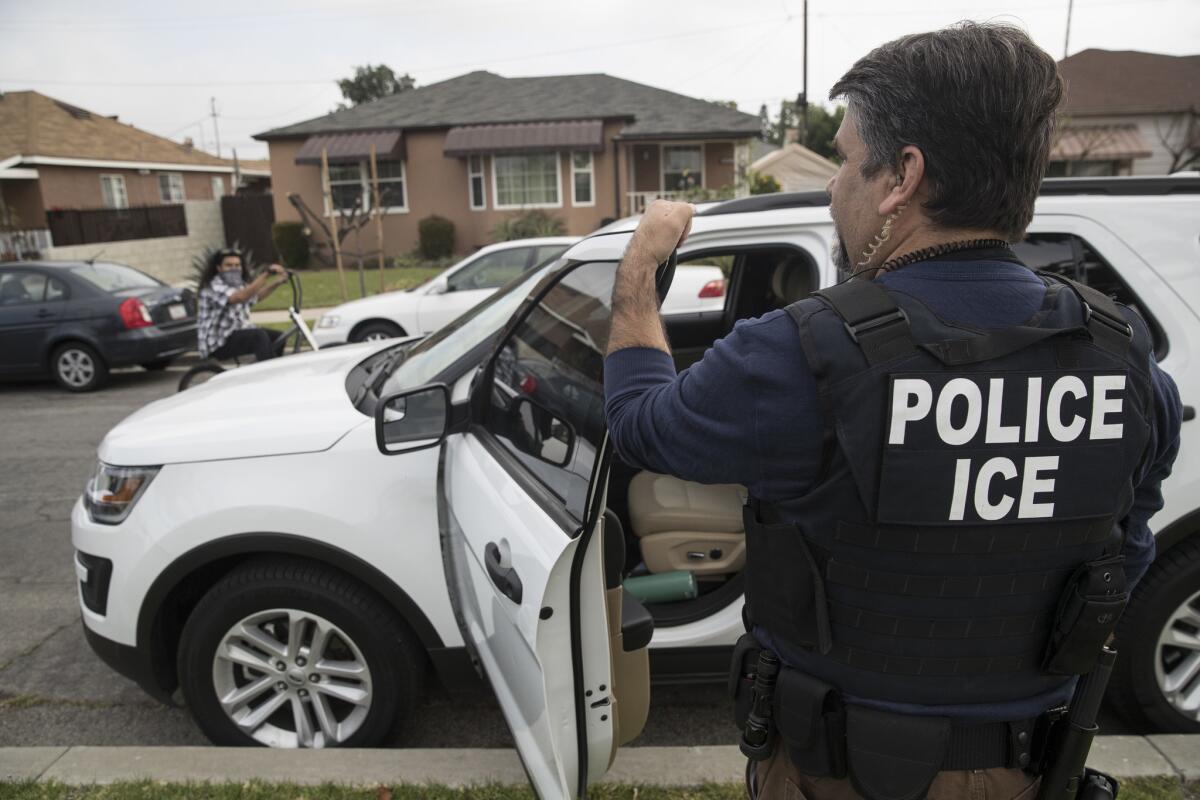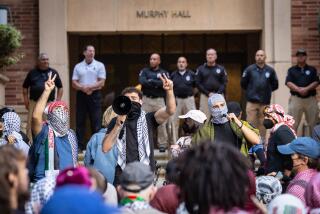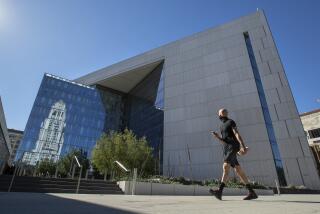Tensions worsen between LAPD and ICE over Trump immigration raids

Tensions between Immigration and Customs Enforcement and Los Angeles police have ramped up over the last month amid the Trump administration’s loud threats to unleash immigration sweeps.
As word spread about a national ICE operation expected to result in thousands of arrests, local officials tried to reassure immigrants in L.A. LAPD Chief Michel Moore said that ICE would target about 140 people in Southern California.
In a video shared last week, Moore also stood beside Mayor Eric Garcetti as he told residents they did not have to open their doors for an ICE agent who does not have a warrant signed by a judge.
The LAPD chief’s actions have provoked anger among ICE officials.
“What’s happened lately, particularly with the chief of police coming out, not only talking about our operation and releasing the numbers, but to do that video he did with the mayor — it’s just really disappointing to us,” said David Marin, the director of Enforcement and Removal Operations for ICE in L.A., as well as the deputy executive associate director for ERO.
Marin said he felt the chief’s actions made ICE’s job harder. “We see that as they’re really putting politics ahead of public safety,” he said.
It’s been longstanding LAPD policy not to enforce federal immigration law, fearing those actions would make those here illegally too afraid to cooperate in crime fighting. Moore and others have stressed this in recent weeks.
Marin said ICE isn’t seeking the LAPD’s help and doesn’t understand why the department keeps raising the issue.
“We’re not asking local law enforcement to enforce immigration law,” Marin said. “So when politicians and others come out and say we will not be helping ICE, we will not be enforcing immigration law — I don’t know where that rhetoric comes from because we’re not asking them to do that.”
Moore defended the decision to release the number — citing the desire to tamp down fear. Word of large-scale operations began to spread after Trump announced in a June 17 tweet that ICE would soon start deporting “millions” of migrants. ICE was believed to actually be focusing on about 2,000 immigrants who have missed court appearances or been ordered to be removed from the U.S.
“My actions and our actions as a law enforcement agency is not meant to offend and should not draw concerns by ICE that we’re somehow obstructing,” Moore said. “We recognize their responsibilities … What we ask is that our communities understand the scope and the actions that are actually going to take place versus the fear and the rumors and the misinformation that appears to be running pretty rampant.”
The relationship between ICE and local law enforcement has long been delicate. Since Trump took office, it has grown only more tenuous as police grapple with maintaining communication with ICE while also balancing transparency with community and city leaders.
Those tensions are especially evident in California, where local law enforcement must abide by a “sanctuary” law, Senate Bill 54, which went into effect last year to provide protection for immigrants in the country illegally. In L.A., the police department stopped engaging in joint operations with ICE that directly involve civil immigration enforcement and no longer transfers people with certain minor criminal convictions to ICE custody.
“As a general matter, the LAPD has been one of the jurisdictions that has promulgated the most immigrant-protective policies,” said Pratheepan Gulasekaram, a professor and immigration expert at Santa Clara University. “Just as a matter of demographics you can understand why the LAPD is not that interested in associating itself with ICE.”
Days after Trump’s initial tweets, Moore told reporters that ICE would conduct sweeps starting June 23 and would be targeting about 140 people as part of the national operation. In an interview with The Times last month, he said his department would not play a role in the arrests and expressed concerns over the possible effects.
“We know how unsettling and scary this is for the community,” Moore said. “We are not an extension of ICE…. I do worry about the intimidation it can create.”
On Tuesday, the LAPD chief told the Police Commission that in the last couple of weeks there have been reports of an increased level of apprehensions in L.A. by ICE.
“What’s being said at the federal level and rumored out of Washington at times strikes me as distinctly different than the ground truth of what’s happening in the street. That’s troubling. It shouldn’t be that way,” Moore said in an interview with The Times. “When the LAPD talks about our enforcement actions, we don’t have false flags and we don’t identify and overstate matters that actually aren’t going to occur.”
After Trump’s tweets, he was criticized for tipping off law enforcement operations – especially after he lambasted Oakland Mayor Libby Schaaf for doing the same thing last year. Asked about this, Marin said the president was not specific in what he shared.
When it comes to the large immigrant population in L.A., the department’s stance dates back to hard-line police chief at the time, Daryl Gates. Its purpose was to build trust so that fear of deportation would not dissuade immigrants who were crime victims or witnesses from cooperating with police.
Special Order 40 prohibited officers from initiating contact with anyone for the sole purpose of learning their immigration status and ruled out arrests for violation of U.S. immigration law.
After Trump took office, the department found itself grappling with a drop in crimes being reported by Latinos. From January to April 2017, there was a decline of more than 23% in sexual assault and a dip of more than 8% in domestic violence incidents reported by Latinos, according to the LAPD.
That prompted officers to update immigration procedures expanding on Special Order 40 and to hold more than 100 forums to remind people that the department’s stance on supporting the estimated 375,000 Los Angeles residents who are in the country illegally remained the same.
Although Trump said last week that operations would begin over the weekend, by Sunday evening there was nothing approaching the mass roundups that the White House had suggested could roll out in several major U.S. cities, including Los Angeles, San Francisco, New York, Chicago, Miami, Denver, Atlanta, Baltimore and Houston.
Though the Trump-announced operations got a lot of attention and generated protests, ICE goes out on large-scale operations three to four times a year in the L.A. area. And every day, agents are also out making arrests.
“We have always been out there arresting people that have final orders, that are criminal aliens, individuals that have been ordered removed,” Marin said. “There are always talks of raids and these larger operations. We don’t just operate in these small windows.”
In the L.A. area in fiscal year 2018, ICE made 7,854 administrative arrests, down nearly 600 from the year before. That number is nowhere near the numbers of arrests in the area for fiscal year 2014 — which totaled nearly 19,000 — or for fiscal year 2013, which totaled roughly 25,000, although those numbers are likely higher because of agencies that previously honored ICE detainers and did not limit or restrict the agency’s access to jails.
“As a result of local law enforcement agencies’ unwillingness or inability to notify ICE when criminal aliens are released from their custody, more criminal aliens are returning back to the communities in which they were arrested,” Marin said. “ICE has had to adjust our enforcement model in a way which has resulted in less arrests and makes ICE more visible in the community.”
Last week, in an L.A. area operation, ICE agents arrested nearly 100 people. The majority of those arrested had criminal records, according to the agency. That operation was separate from the ones Trump announced.
Over the weekend, protests were held in cities including Los Angeles, Chicago, Denver and Philadelphia. At one immigration detention center in Washington state, a man armed with a rifle and throwing incendiary devices died Saturday after four police officers arrived and opened fire.
Marin referenced the incident in Washington state, as well as cases of employees being threatened and protesters showing up at agents’ homes to protest.
“I totally value and respect people’s right to assemble and voice their 1st Amendment rights … but to threaten others’ lives and to put other people in harm’s way is just not right, especially when these are men and women that are sworn to uphold the law,” Marin said. “Our job is to enforce the laws that Congress has established. We’re not law interpretation officers, we’re law enforcement officers.”
Times staff writer Mark Puente contributed to this report.
More to Read
Sign up for Essential California
The most important California stories and recommendations in your inbox every morning.
You may occasionally receive promotional content from the Los Angeles Times.











